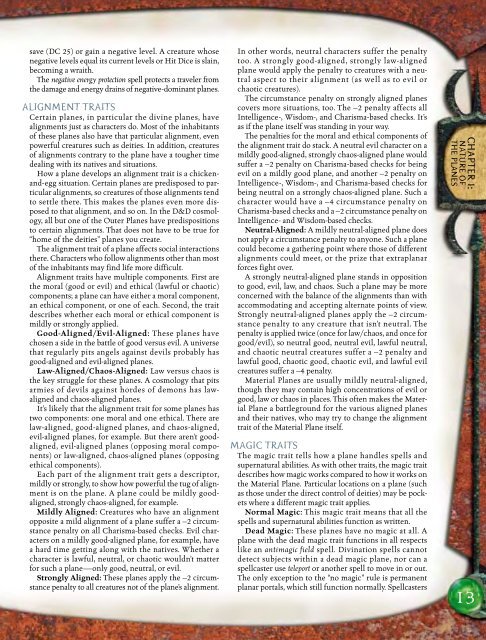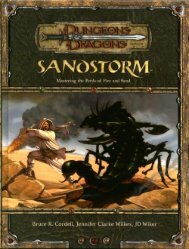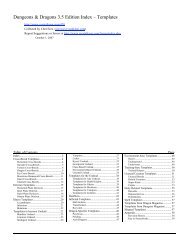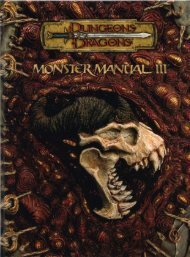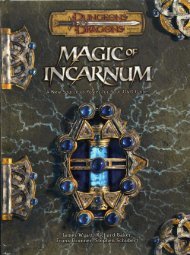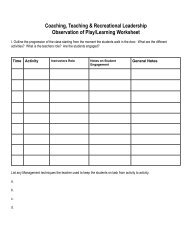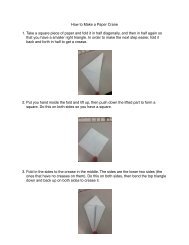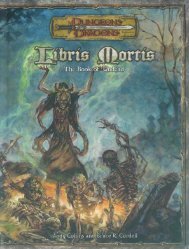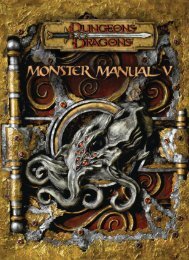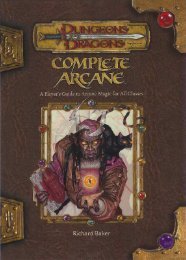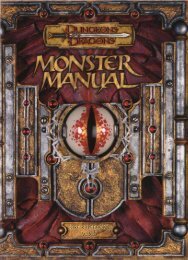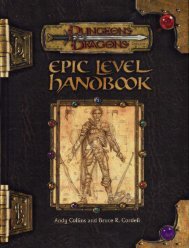Manual of the Planes
Manual of the Planes
Manual of the Planes
- No tags were found...
You also want an ePaper? Increase the reach of your titles
YUMPU automatically turns print PDFs into web optimized ePapers that Google loves.
save (DC 25) or gain a negative level. A creature whosenegative levels equal its current levels or Hit Dice is slain,becoming a wraith.The negative energy protection spell protects a traveler from<strong>the</strong> damage and energy drains <strong>of</strong> negative-dominant planes.ALIGNMENT TRAITSCertain planes, in particular <strong>the</strong> divine planes, havealignments just as characters do. Most <strong>of</strong> <strong>the</strong> inhabitants<strong>of</strong> <strong>the</strong>se planes also have that particular alignment, evenpowerful creatures such as deities. In addition, creatures<strong>of</strong> alignments contrary to <strong>the</strong> plane have a tougher timedealing with its natives and situations.How a plane develops an alignment trait is a chickenand-eggsituation. Certain planes are predisposed to particularalignments, so creatures <strong>of</strong> those alignments tendto settle <strong>the</strong>re. This makes <strong>the</strong> planes even more disposedto that alignment, and so on. In <strong>the</strong> D&D cosmology,all but one <strong>of</strong> <strong>the</strong> Outer <strong>Planes</strong> have predispositionsto certain alignments. That does not have to be true for“home <strong>of</strong> <strong>the</strong> deities” planes you create.The alignment trait <strong>of</strong> a plane affects social interactions<strong>the</strong>re. Characters who follow alignments o<strong>the</strong>r than most<strong>of</strong> <strong>the</strong> inhabitants may find life more difficult.Alignment traits have multiple components. First are<strong>the</strong> moral (good or evil) and ethical (lawful or chaotic)components; a plane can have ei<strong>the</strong>r a moral component,an ethical component, or one <strong>of</strong> each. Second, <strong>the</strong> traitdescribes whe<strong>the</strong>r each moral or ethical component ismildly or strongly applied.Good-Aligned/Evil-Aligned: These planes havechosen a side in <strong>the</strong> battle <strong>of</strong> good versus evil. A universethat regularly pits angels against devils probably hasgood-aligned and evil-aligned planes.Law-Aligned/Chaos-Aligned: Law versus chaos is<strong>the</strong> key struggle for <strong>the</strong>se planes. A cosmology that pitsarmies <strong>of</strong> devils against hordes <strong>of</strong> demons has lawalignedand chaos-aligned planes.It’s likely that <strong>the</strong> alignment trait for some planes hastwo components: one moral and one ethical. There arelaw-aligned, good-aligned planes, and chaos-aligned,evil-aligned planes, for example. But <strong>the</strong>re aren’t goodaligned,evil-aligned planes (opposing moral components)or law-aligned, chaos-aligned planes (opposingethical components).Each part <strong>of</strong> <strong>the</strong> alignment trait gets a descriptor,mildly or strongly, to show how powerful <strong>the</strong> tug <strong>of</strong> alignmentis on <strong>the</strong> plane. A plane could be mildly goodaligned,strongly chaos-aligned, for example.Mildly Aligned: Creatures who have an alignmentopposite a mild alignment <strong>of</strong> a plane suffer a –2 circumstancepenalty on all Charisma-based checks. Evil characterson a mildly good-aligned plane, for example, havea hard time getting along with <strong>the</strong> natives. Whe<strong>the</strong>r acharacter is lawful, neutral, or chaotic wouldn’t matterfor such a plane—only good, neutral, or evil.Strongly Aligned: These planes apply <strong>the</strong> –2 circumstancepenalty to all creatures not <strong>of</strong> <strong>the</strong> plane’s alignment.In o<strong>the</strong>r words, neutral characters suffer <strong>the</strong> penaltytoo. A strongly good-aligned, strongly law-alignedplane would apply <strong>the</strong> penalty to creatures with a neutralaspect to <strong>the</strong>ir alignment (as well as to evil orchaotic creatures).The circumstance penalty on strongly aligned planescovers more situations, too. The –2 penalty affects allIntelligence-, Wisdom-, and Charisma-based checks. It’sas if <strong>the</strong> plane itself was standing in your way.The penalties for <strong>the</strong> moral and ethical components <strong>of</strong><strong>the</strong> alignment trait do stack. A neutral evil character on amildly good-aligned, strongly chaos-aligned plane wouldsuffer a –2 penalty on Charisma-based checks for beingevil on a mildly good plane, and ano<strong>the</strong>r –2 penalty onIntelligence-, Wisdom-, and Charisma-based checks forbeing neutral on a strongly chaos-aligned plane. Such acharacter would have a –4 circumstance penalty onCharisma-based checks and a –2 circumstance penalty onIntelligence- and Wisdom-based checks.Neutral-Aligned: A mildly neutral-aligned plane doesnot apply a circumstance penalty to anyone. Such a planecould become a ga<strong>the</strong>ring point where those <strong>of</strong> differentalignments could meet, or <strong>the</strong> prize that extraplanarforces fight over.A strongly neutral-aligned plane stands in oppositionto good, evil, law, and chaos. Such a plane may be moreconcerned with <strong>the</strong> balance <strong>of</strong> <strong>the</strong> alignments than withaccommodating and accepting alternate points <strong>of</strong> view.Strongly neutral-aligned planes apply <strong>the</strong> –2 circumstancepenalty to any creature that isn’t neutral. Thepenalty is applied twice (once for law/chaos, and once forgood/evil), so neutral good, neutral evil, lawful neutral,and chaotic neutral creatures suffer a –2 penalty andlawful good, chaotic good, chaotic evil, and lawful evilcreatures suffer a –4 penalty.Material <strong>Planes</strong> are usually mildly neutral-aligned,though <strong>the</strong>y may contain high concentrations <strong>of</strong> evil orgood, law or chaos in places. This <strong>of</strong>ten makes <strong>the</strong> MaterialPlane a battleground for <strong>the</strong> various aligned planesand <strong>the</strong>ir natives, who may try to change <strong>the</strong> alignmenttrait <strong>of</strong> <strong>the</strong> Material Plane itself.MAGIC TRAITSThe magic trait tells how a plane handles spells andsupernatural abilities. As with o<strong>the</strong>r traits, <strong>the</strong> magic traitdescribes how magic works compared to how it works on<strong>the</strong> Material Plane. Particular locations on a plane (suchas those under <strong>the</strong> direct control <strong>of</strong> deities) may be pocketswhere a different magic trait applies.Normal Magic: This magic trait means that all <strong>the</strong>spells and supernatural abilities function as written.Dead Magic: These planes have no magic at all. Aplane with <strong>the</strong> dead magic trait functions in all respectslike an antimagic field spell. Divination spells cannotdetect subjects within a dead magic plane, nor can aspellcaster use teleport or ano<strong>the</strong>r spell to move in or out.The only exception to <strong>the</strong> “no magic” rule is permanentplanar portals, which still function normally. SpellcastersCHAPTER 1:NATURE OFTHE PLANES13


